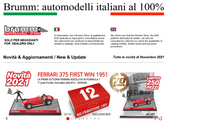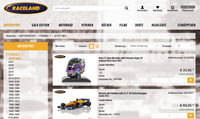Blogs 2019
50 years ago: First title for Stewart and Matra
On 7th of September 50 years ago Jackie Stewart won his first world championship at Monza at the wheel of a Matra. With four races to go, it was not a question of if, but rather when Jackie Stewart would clinch the world championship. The Scotsman had demonstrated a dominance like only Jim Clark had done before. Of the first seven races in 1969, Jackie had won five. In that year the rules were that the best five scores from the first six races and the best four results of the last five races counted towards the championship. That meant: Second placed Jacky Ickx could only score 36 points in the second half of the season. Which meant he would achieve a maximum of 58. Stewart already had 51 points before Monza. So the situation was clear: If Stewart would win in Monza he was crowned for the first time. And so it came. In an epic slipstream battle Stewart won the race in front of Jochen Rindt (0,08 sec behind) and Jean-Pierre Beltoise (0,17 sec). As the cars came out of Parabolica for the 68th and final time, four possible winners were going to battle for the win. “It was a real photo finish”, remembers Stewart, which was topped two years later at Monza with even smaller margins at the chequered flag. “It felt like a dream come true. But I have to say that the Matra I had this year was also one of the best cars I have ever driven.” In fact: Stewart only had two mechanical failures that year. In Monaco he had to stop when leading the race because of a broken driveshaft. At the final race in Watkins Glen his engine blew up.
Stewarts first world championship was also the first (and only) Formula One crown won by Matra. The French manufacturer gave its debut in Formula One in 1968 with Jean-Pierre Beltoise and Henri Pescarolo at the wheel of a MS7 respectively MS10 as a factory team. Parallel to the factory team Ken Tyrrell also entered chassis made by Matra for his proper racing squad, called Matra International. Because Tyrrell was much more successful with his client team (3 victories already in 1968) Matra decided to step out as a factory team in 1969 and concentrated on working together with Tyrrell. This decision proved to be right. Matra was not only the first French manufacturer who won the title, it took another 36 years until the next French title (Renault with Fernando Alonso in 2005) was secured. Even though Matra gave its comeback in 1970 as a factory team, the French manufacturer couldn’t establish itself in Formula One. At the end of 1972 the team from Vélizy-Villacoublay (close to Paris) pulled out. In the meantime Ken Tyrrell established his own team: Tyrrell Racing.
Even it is only a small period in which Matra left its fingerprint in Formula One there are plenty of modelcars of the French manufacturer. Starting with the newly released models I have to point out the different versions made by Spark. Beginning with the MS11 from 1968 which even exists as a presentation car, Spark has also different versions of the MS80 from 1969 in its program – including the version of the Monza Grand Prix driven by Stewart with #20. Spark also released the Matras of the second factory era from 1970 to 1972, incl. the MS120, the MS120B and the MS120D. Another manufacturer which released Formula One models made by Matra is Quartzo. But as far as I know they only did the MS80 in different versions.
Going back to the good old times when modelcars were real toys you have to mention of course some nice 1:43 V8-Matras by Dinky Toys as well as Solido. The later was reproduced by Brosol in Brazil and in the late eigthies also by Verem. But there were other interesting models. Such as the plastic imitation of a MS80 made by Minialuxe, in 1:43. One of the nicest Matra in a smaller scale is the one made by Safir/Champion in 1:60. It was available in two versions – with and without rearwing. Later the Matra MS120 was added to this series. This model was available in three different versions, even though the one in orange and the one in purple are far from being original. Galgo from Argentina had a Matra in its program as well. I know two different versions: one in light blue, the other in yellow. Both models are rude but as far as I know the Matra was the first Formula One car Galgo released – followed by many other Formula One cars from the seventies and eighties. Two more Matras should be mentioned in 1:66: the one of Schuco as well as a plastic/die-cast imitation of a MS120 made by Barlux from Italy.
Some manufacturer also had larger scaled Matras in its program. The most common is Schuco in 1:16. This car is part of the Grand Prix series which was a huge success for the German toymaker at the end of the sixties to the mid-seventies. A simple but nice Matra also exist from Polistil in 1:32. There are many different versions around. The early models from this series, called F series, were made under the label of Politoys. The later versions were named by Polistil. A bit later than Polistil Italian manufacturer Mebetoys also released a Formula One series in which the Matra MS120 was part of it – in the original blue as well as in yellow. Later this model was copied by Gorgo from Argentina. #7th September 2019
German version to follow / deutsche Übersetzung folgt
When Formula One lost their high wings
Formula One has seen many strange constructions. One of it were quite trendy at the end of the sixties: the high wings – which were mounted to increase downforce. First at the back of the car. Later also at the front. In both cases the wings looked fragile, some of them even terrifying.
Wings were already popular in 1928 when Fritz von Opel put two of them on his RAK2-Raketenfahrzeug. One on the left, one on the right side of the cockpit. Almost 30 years later Swiss driver Michael May surprised everybody with a huge wing on his Porsche 550 Spyder. With this construction May was faster than the factory Porsche of Juan-Manuel Fangio and Jean Behra. That was intolerable for sporting director Huschke von Hanstein. He went to the stewards and protested against the Porsche of May. The stewards agreed and rated the wing as too dangerous.
It took another ten years until the next smart engineer experimented with wings on race cars: Jim Hall with his legendary Chaparral 2F. This time the developments swapped over to Formula One. And it was Lotus founder Colin Chapman who first mounted a rearwing on his Lotus 49 at the Grand Prix of Monaco in 1968. Because Graham Hill was immediately quicker with the modified Lotus the other teams soon began to copy the idea with the wing.
The first imitator was Ferrari. Designer Mauro Forghieri added a rearwing on Chris Amons 312/67 for the next race in Spa-Francorchamps. Unlike Chapman's bent metal sheet, Forghieri designed a genuine upturned wing – with success. Amon got pole-position. And he went almost six seconds quicker per lap than local hero and teammate Jacky Ickx who had no rearwing.
«Colin Chapman first mounted
a rearwing on his Lotus 49 in
Monaco 1968.» f1modelcars.com
At the next races almost every team modified their cars with rear wings. And at the beginning of 1969, 50 years ago, some teams experimented even with two large wings. One at the back, one at the front. Both wings could be adjusted from the cockpit during races and practices.
Before Formula One headed to Montjuich in 1969 there were already some issues with the high wings. Mainly because they were too fragile. In Spain it even came worse. First it was Graham Hill who went off during race because his wing was broken. Ten laps later it was teammate Jochen Rindt who crashed heavily at the same place. He even hit the car of Hill which was still standing there. Rindt luckily escaped with a broken nose bone.
The reason of both crashes was never solved. But it is obvisous that the mounting of the high rear wings collapsed due to the high forces under race condition. To avoid these kind of accidents the high wings were banned. Instead the technicans constructed new wings. First smaller ones, than they became bigger and bigger. But never again that high as in 1968 and 1969. Of course there are many different model cars with high wings from that period. Spark has some very nice examples of the Matra MS10 or MS80. Quartzo as well had a nice range of high wing Formula One cars (especially Lotus and Matra) at the time the company from Portugal were one of the top-seller. Model cars with high wings also exists from the period itself. Corgi Toys, Dinky Toys and Solido produced some various models with either plastic or die-cast wings in 1:43. In the case of Corgi Toys the yellow Cooper-Maserati and the orange Lotus-Climax were released with a high rear wing which can be adjusted like the original ones. There is also a bunch of smaller Formula One model cars at around 1:60 – such as Polistil, Champion, Majorette, Efsi or Zylmex – with high rear wings. So high wings in a way inspired the model car industry and they are a witness of a time when Formula One was dangerous and sex was safe… #27th June 2019
Es hat schon viele verrückte Konstruktionen in der Formel 1 gegeben. Eine davon war Ende der Sechzigerjahre en vogue: die hohen Flügel, die den Abtrieb verbessern sollten. Die ersten, auf Stelzen montierten Flügel tauchten am Heck auf. Später wurden welche auch auf der Schnauze montiert. In beiden Fällen machten die Flügel einen zerbrechlichen Eindruck. Manche sahen geradezu furchterregend aus.
Die ersten Flügel im Rennsport tauchten 1928 am RAK2-Raketenfahrzeug von Fritz von Opel auf. Einer links, der andere rechts vom Cockpit. 30 Jahre später feierte der Heckflügel sein Debüt. Der Schweizer Rennfahrer Michael May montierte einen riesigen Heckflügel auf seinem Porsche 550 Spyder. Mit diesem Ungetüm war May schneller als die Werks-Porsche von Juan-Manuel Fangio und Jean Behra. Das konnte Porsche-Rennleiter Huschke von Hanstein so nicht auf sich sitzen lassen. Er ging zur Rennleitung und protestierte gegen Mays Konstruktion. Diese gab ihm Recht und sprach ein Verbot gegen solche Flügel aus.
Es vergingen weitere zehn Jahre, ehe ein anderer cleverer Ingenieur mit Flügeln auf Rennautos experimentierte: Jim Hall. Auf dem Chaparral 2F des Amerikaners thronte ein riesiger Heckspoiler. Und diesmal schwappte die Idee auch in die Formel 1 über. Lotus-Gründer Colin Chapman war der erste, der seinen Autos einen Heckspoiler verpasste. Beim Grossen Preis von Monaco rückte Graham Hill mit einem beflügelten Lotus 49 aus. Weil er auf Anhieb schneller war als die Konkurrenz, begann diese Chapmans Idee zu kopieren.
«Colin Chapman hat 1968 in Monaco
als Erster seinem Lotus 49 einen
Heckflügel verpasst.» f1modelcars.com
Die erste Imitation lieferte Mauro Forghieri beim Grand Prix von Belgien in Spa-Francorchamps. Der Ferrari-Designer schraubte an Chris Amons 312/67 einen Heckflügel. Dieser war anders als derjenige von Chapman. Während Chapman eigentlich nur ein Blech ans Heck montierte, konstruierte Forghieri einen echten Flügel mit einem umgekehrten Profil. Und das mit Erfolg. Amon sicherte sich die Pole-Position. Und er war fast sechs Sekunden pro Runde schneller als Lokalmatador und Teamkollege Jacky Ickx, der ohne Heckflügel unterwegs war.
Beim nächsten Rennen rückten fast alle Teams mit Heckflügeln aus. Und Anfang 1969, also vor genau 50 Jahren, experimentieren einige Rennställe sogar mit zwei auf Stelzen getragenen Flügeln. Einer hinten, der andere vorne. Beide konnten vom Cockpit aus während der Fahrt verstellt werden.
Bevor die Formel 1 1969 ihre Zelte in Montjuich aufschlug, gab es aufgrund der äusserst zerbrechlichen Konstruktionen bereits ein paar Zwischenfälle mit den hohen Flügeln. In Spanien kam es dann beinahe zum GAU. Zuerst traf es Graham Hill. Der Brite verunfallte im Rennen, weil der Flügel an seinem Lotus 49 kollabierte. Zehn Runden später verunglückte auch Teamkollege Jochen Rindt schwer. Dieser flog an derselben Stelle wie Hill ab und krachte in das Wrack von Hill am Streckenrand. Rindt hatte Glück im Unglück. Er entstieg seinem komplett zerstörten Lotus mit einem gebrochenen Nasenbein.
Die Gründe für die Unfälle der beiden Lotus-Fahrer konnten nie bis ins letzte Detail aufgedeckt werden. Es war aber offensichtlich, dass die Flügelkonstruktionen unter der Last im Rennen gebrochen waren. Um solche Unfälle in Zukunft zu vermeiden, wurden der Formel 1 die Flügel gestutzt. Geblieben sind kleinere Front- und Heckspoiler, die mit den Jahren dann vor allem in Breite, aber nicht mehr in die Höhe gewachsen sind. Natürlich gibt es zahlreiche F1-Modelle, die an die Zeit mit den hohen Stelzen-Flügeln erinnern. Zum Beispiel von Spark. Der Branchenleader hat ein paar sehr schöne Matra MS10 und MS80 im Programm. Auch Quartzo hat in seiner Blütezeit ein paar interessante Exemplare an Lager. Ich erinnere zum Beispiel an Modelle von Lotus und Matra. Die hohen Flügel haben aber auch schon Modellbauer von früher bewogen, diesen Ungetümen auf Stelzen einen würdigen Platz zu geben. Corgi Toys, Dinky Toys und Solido haben in 1:43 einige Modelle mit Flügeln aus Plastik oder Die-Cast produziert. Corgi hat sogar beim gelben Cooper-Maserati und beim orangen Lotus-Climax Flügel angebracht, die wie beim Original beweglich waren. Es gab auch eine Handvoll F1-Modelle in der damaligen Zeit in kleineren Massstäben (ca. 1:60), die dem Trend mit den hohen Flügeln Rechnung trugen. Spontan fallen mir Modelle von Polistil, Champion, Majorette, Efsi und Zylmex ein. Die hohen Flügel 1968 und 1969 stammen also nicht nur aus einer Zeit, als Rennsport gefährlich und Sex sicher war, sie haben auch die Modellautoindustrie beflügelt. #27. Juni 2019
Niki Lauda, 1949-2019
There were only a few people in Formula One which were sadly missed after their death. Niki Lauda is for sure one of them. Lauda was a legend. Not only as a driver but also as a human being who represented somebody who never gave up. He was straightforward in anything he did. As a driver, as a manager of a Formula One team or an airline or even as a private person. The death of Lauda is one of the biggest loss for Formula One. He was Formula One. All over the world.
Laudas career in Formula One started in 1971 at the Austrian Grand Prix. In 1972 he remained at March where he had to pay two million of Austrian Schillings to race for which was at that time almost 100’000 US dollars. Laudas talent was obvious. But it took another year with B.R.M. until he was hired by Enzo Ferrari. In 1974 Lauda won his first race at Jarama in Spain. And in 1975, in its second year for the Scuderia, he won the title. On the way to the second championship Lauda crashed heavily at the Nürburgring in 1976. In the hospital Lauda got the last rites. But he fought back miraculously. Only 42 days after his crash in Germany he gave his comeback in Monza with severe combustions. Lauda became fourth in this race. And from that moment on he was a legend.
In the last race in Fuji/Japan he was still fighting for the championship. But in heavy rain conditions he parked his car after two laps. He considered the situation as too dangerous. And let James Hunt won the title. In 1977 it was again Lauda and Ferrari who won the title. But he didn’t feel comfortable anymore and switched to Brabham and his friend Bernie Ecclestone who was team principal of Brabham at that time for the following season. He won two races with Brabham, one of it at Sweden with the legendary fan car which was forbidden after this race.
In Canada 1979 he quit Formula One. From one minute to another. And started to became a successful entrepreneur in the aircraft business. In 1982 Lauda gave his comeback in Formula One at McLaren. Like everything he did in his life he was determined to win again. And in 1984 he became world champion for the third time with McLaren. Already at that time Lauda knew that his teammate Alain Prost was quicker than him. And one year later he stopped racing and returned to his aircraft business. He followed Formula One and returned in 1993 in a managing role at Ferrari. In 2001 he even became teamprincipal of Jaguar which was maybe the only task in which he didn’t succeed. From 2012 on he was appointednon-executive chairman of the Mercedes AMG Petronas F1 Team. One of his biggest achievement was to persuade Lewis Hamilton to join Mercedes in 2013.
«In Canada 1979 he quit
Formula One. From one minute
to another.» f1modelcars.com
As a consequence of his crash at the Nürburgring in 1976 Lauda got a kidney from his brother in 1997. When the kidney from his brother failed he got another one from Birgit Wetzinger, a former flight attendant who became Laudas wife in 2008. On August 2 nd, 2018 it was announced that Lauda had successfully undergone a lung transplant operation in his native Austria. But from that he never really recovered. On May 20th he died at the age of 70 years at the University Hospital of Zürich, where he had been undergoing dialysis treatment for kidney problems.
Due to the fact that Lauda was a legend already at lifetimes quite a few cars he drove exist as a modelcar. Especially Italian manufacturer Polistil devoted him a lot of different Ferraris. Like for example the Ferrari 312 B3 which was issued by Polistil in 1:16. There are of course also different versions of the 312 T2 which was raced by Lauda in 1976 and 1977. One of the rarest models is the one with six wheels which was tested by Lauda on March 10 th in 1977 at Fiorano. But I also would like to mention the two 312 T2 models made by Eidai in 1:20 and 1:43. Or the very rare one made by Nikko from Japan in 1:27. Polistil, Yaxon, Bburago (and later Minichamps) also released the Brabham Lauda drove in 1978 with #1. One shouldn't forget also the B.R.M. P160 which was made by Schuco in 1:16. In this car Lauda won his first worldchampionship points at the Belgian Grand Prix 1973. It is also available in 1:43 by Spark.
In the Eighties Formula One modelcars were not really common. With one exception: As part of the Grand Prix series Bburago launched Laudas title winning McLaren 1984 in 1:24. Today quite a few Cars Lauda drove in Formula one are available. Thanks to Minichamps, Spark or True Scale in 1:43. Such as the early cars from March or B.R.M. Or some of his Brabhams or McLarens.
If I have to point out one specific car which is strongly connected to Lauda I would mention the Ferrari 312T from 1975. This car exists in different scales from different manufacturers like Minichamps, IXO, Looksmart, Quartzo or Safir. For me this is the car which reminds me the most of Niki Lauda. A man who dedicated his life to Formula One. #20th May 2019
Es gibt nur ein paar Menschen, die mit ihrem Tod eine grosse Lücke in der Formel 1 hinterlassen haben. Niki Lauda zählt mit Sicherheit zu ihnen. Und das nicht nur als Rennfahrer, sondern auch als einer der Charaktere, die nie aufgegeben hat. In allem, was er tat, war er geradeaus. Als Fahrer, als Manager eines Formel-1-Teams oder seiner Airline, aber auch als Privatperson. Der Tod Von Niki Lauda ist einer der schwersten Verluste für die Formel 1. Er war der Inbegriff der Formel 1. Überall – auf der ganzen Welt.
Laudas Formel-1-Karriere begann 1971 beim Grossen Preis von Österreich am Steuer eines March. Für dieses Team fuhr er 1972. Zwei Millionen Schilling musste er damals mitbringen. Das waren damals umgerechnet rund 100'000 US Dollar. Laudas Talent war offensichtlich. Aber es dauerte noch ein Jahr mit B.R.M., ehe er für 1974 von Enzo Ferrari engagiert wurde. Seinen ersten Sieg feierte Lauda beim Grossen Preis von Spanien in Jarama. Schon im zweiten Jahr für Ferrari wurde Lauda Weltmeister. Auf dem Weg zum zweiten Titel 1976 verunfallte Lauda am Nürburgring schwer. Im Krankenhaus bekam er sogar seine letzte Ölung. Doch der Kämpfer Lauda gab nicht auf und gab nur 42 Tage nach seinem Feuerunfall sein Comeback in Monza. Gezeichnet von schweren Verbrennungen wurde Lauda in diesem Rennen, das ihn zur Legende machte, Vierter.
Im letzten Rennen der Saison in Japan war Lauda immer noch im Titelrennen. Doch in der Regenschlacht von Fuji parkte Lauda seinen Ferrari nach nur zwei Runden an der Box. Es war ihm zu riskant. Der Titel ging an James Hunt. 1977 waren es erneut Lauda und Ferrari, die das Rennen machten. Doch Lauda fühlte sich bei der Scuderia nicht mehr wohl. Und wechselte auf die neue Saison zu Brabham, wo sein Kumpel Bernie Ecclestone den Posten des Teamchefs inne hatte. Lauda gewann zwei Rennen, eines davon in Schweden mit dem «Staubsauger», den Brabham danach im Museum verschwinden liess, weil er illegal war.
In Kanada 1979 hängte Lauda den Helm an den Nagel. Von einer Minute auf die andere. Danach widmete er sich der Luffahrt, wo er als cleverer Manager schon bald seine eigene Airline hatte. 1982 gab Lauda bei McLaren ein Comeback in der Formel 1. Wie alles, was er im Leben anpackte, wollte er auch hier beweisen, dass er immer noch gewinnen kann. Und tatsächlich: 1984 wurde Lauda mit McLaren zum dritten Mal Formel-1-Weltmeister. Schon damals spürte Lauda aber, dass sein Teamkollege Alain Prost immer schneller wurde. Ein Jahr nach seinem dritten Titelgewinn trat Lauda zum zweiten Mal von der GP-Bühne ab. Und wieder widmete er sich fortan intensiv seiner Fluggesellschaft. 1993 kam Lauda als Berater von Ferrari zurück in die Formel 1. 2001 nahm der Wiener dann sogar den Posten als Teamchef bei Jaguar an. Es war einer der wenigen Jobs, in denen Lauda keinen Erfolg vorweisen konnte. Von 2012 bis heute war Lauda dann Aufsichtsratvorsitzender des Mercedes AMG Petronas F1-Teams. Eine seiner grössten Leistungen in dieser Zeit war es, Lewis Hamilton zu überzeugen, dass er mit Mercedes Erfolg haben kann.
Als Folge seines Unfalls am Nürburgring 1976 musste Lauda 1997 eine Niere seines Bruders verpflanzt. Als diese ihren Dienst quittierte, war es Birgit Wetzinger, eine ehemalige Flight Attendant, die Lauda 2008 heiratete, die ihm abermals eine Niere schenkte. Am 2. August 2018 musste Lauda erneute operiert werden. In Österreich wurde ihm eine Lunge transplantiert. Von dieser OP schien er sich nie mehr richtig zu erholen. Am 20. Mai starb Lauda im Alter von 70 Jahren im Universitätsspital Zürich, wo er für eine Nieren-Dialyse zur Untersuchung war.
«In Kanada 1979 hängte Lauda
den Helm an den Nagel. Von einer Minute
auf die andere.» f1modelcars.com
Weil Lauda schon zu Lebzeiten eine Legende war, gibt es einige Modellautos von ihm. Insbesondere der italienische Hersteller Polistil hat Lauda in seiner Zeit bei Ferrari zahlreiche Modelle gewidmet. Zum Beispiel der Ferrari 312 B3, den Polistil in 1:16 auf den Markt brachte. Aber es gibt auch zahlreiche Modelle des Ferrari 312 T2, den Lauda 1976 und 1977 fuhr. Eines der seltenen Modelle ist der Sechsrad-Ferrari, den Lauda am 10. März 1977 in Fiorano testete. Aber auch die beiden Modelle von Eidai in 1:20 und 1:43 sind erwähnenswert. Genauso wie der 312 T2 von Nikko aus Japan in 1:27. Polistil, Yaxon, Bburago (und später Minichamps) haben auch zahlreiche Varianten des Brabham von 1978 mit der Startnummer 1 herausgebracht. Nicht vergessen sollte man auch den B.R.M. P160, den Schuco in 1:16 verkleinerte. Mit diesem Auto gewann Lauda seine ersten WM-Punkte beim Grossen Preis von Belgien 1973. Von dem Modell gibt es inzwischen auch eine 1:43-Verkleinerung von Spark.
In den Achtzigerjahren, als F1-Modellautos Mangelware waren, war es Bburago, die Lauda mit dem Weltmeister-McLaren von 1984 in 1:24 würdigten. Heute gibt es zahlreiche Lauda-Modelle – dank Minichamps, Spark oder True Scale in 1:43. Als da wären die March aus der Anfangszeit, der B.R.M. oder eben die Brabhams und McLarens.
Wenn ich ein besonderes Lauda-Modell herauspicken müsste, wäre das der Ferrari 312T von 1975. Dieser Wagen existiert von verschiedenen Anbietern in verschiedenen Grössen. So zum Beispiel von Minichamps, IXO, Looksmart, Quartzo oder Safir. Und er erinnert mich am meisten an Lauda. Ein Mensch, der sein Leben der Formel 1 verschrieben hat. #20. Mai 2019
Imola 1994: 25 years ago
Ten years ago Formula One has seen many tragedies. The weekend of Imola from Aprile 29 th to May 1 st 1994 was one of the sadest days in the history of motorsport by far. On Friday there was this frightening accident of Rubens Barrichello from which the Brazilian escaped luckily and was back with a injured arm in the evening. On Saturday Austrian rookie Roland Ratzenberger died in his Simtek. It was the first fatal accident in Formula One since Elio de Angelis in Le Castellet 1986 during testing. Formula One was shocked, but the black weekend at Imola was not over yet. The race started with an collision between Pedro Lamy who crashed into the back of J.J. Lehto who stalled his Benetton on the grid. There were debris all over the track. But the race continued behind the safety-car – an Opel Vectra which was far too slow. Many drivers complained that the temperature in their tyres was not how it should be. When the race was green flagged Sennas car hit the ground several times. When he came to Tamburello which at that time was a highspeed-corner the Williams of the three-times-worldchampion went straight off and hit the wall. Sennas head got hit by a part of the suspension. He had no chance to survive.
That weekend Formula One lost not only one of their greatest driver. It was the end of an era. Sennas death changed Formula One dramatically. Under the guidance of Max Mosley, at that time president of the FIA, the cars and the racetracks became safer and safer. So many drivers survived heavy accidents after Imola 1994 because Senna and Ratzenberger lost their lives.
The legacy of Senna is huge. 25 years later he is still in the heart of almost any racing fans. Not only in Brazil. But also all over the world. I do not want to launch a discussion about who was the best racing driver. I think you can’t compare the fifties with the eighties, nor with today. But I have to say that Senna lived in a period where the cars were powerful and the competition was huge. He had to fight against Prost, Mansell and Piquet – something other drivers before or after him didn’t have to. And he put everything – from the physical to the mental side – on a new level. I am proud having seen him in action several times. On track or in the paddock. He had an aura which I will never forget. And which I never experienced at any other racing driver afterwards.
As a model collector and a fan of Ayrton Senna it is of course a pleasure to see that almost every car driven by Senna is – thanks to Minichamps – available in 1:43. Most of them do also exist in 1:18. Some of them even in 1:12 – like the McLaren MP4/4 from 1988 (Sennas first title), the wonderful JPS-Lotus 97T from 1985 (first victory) or the Williams FW16 in which he died in 1994. There are also some other models driven by Senna. For example by Kyosho in 1:64 which released a series of Lotus F1 cars. Or of course by Onyx in 1:43 and 1:24. There even exist some models from Onyx which were made exclusively for the Brazilian market. There were named VC Models. Tomica did some models from Senna as well in 1:55 – a reason for that is that Senna was loved by the Japanese fans as a Honda ambassador. Also Tamiya, well known for their accurate plastic kits, released a die-cast-model of the McLaren MP4/6 from 1991 in 1:20 as part of their Collectors Club.
While speaking about Senna one shouldn’t forget Roland Ratzenberger. He was new in Formula One in 1994. And he had no other choice than to buy in a Simtek, a newly founded team with almost no budget. Ratzenberger couldn’t live his dream for a long time. After a DNQ in the seasonopener at Brazil the 33 year old from Salzburg became 11 th in the second race of the season in Aida. At Imola he was on his way to qualify for his second race when he crashed after his frontwing collapsed. The only modelcar from the Austrian is made by Minichamps in 1:43. It shows the Simtek S941 with the typical helmet in red and white, the colours of Austria. #1st May 2019
Die Formel 1 hat viele Tragödien gesehen. Das Imola-Wochenende vom 29. April bis 1. Mai 1994 war bei weitem eines der schlimmsten im Motorsport. Am Freitag verunfallte Rubens Barrichello schwer. Der Brasilianer hatte Glück. Er kam glimpflich davon und tauchte am Abend mit dem Arm in der Schlinge schon wieder im Fahrerlager auf. Am Samstag dann der tödliche Crash des Österreichers Roland Ratzenberger. Es war der erste tödliche Unfall in der Formel 1 seit Elio de Angelis, der bei Testfahrten in Le Castellet 1986 ums Leben kam. Die Formel 1 stand unter Schock. Aber das schwarze Wochenende von Imola war noch nicht vorüber. Das Rennen startete mit einer Kollision. Pedro Lamy krachte am Start in den stehengebliebenen Benetton von J.J. Lehto. Überall lagen Trümmerteile. Doch das Rennen ging hinter dem Safety-Car weiter – einem Opel Vectra, der viel zu langsam war. Viele Fahrer beklagten sich, dass die Temperaturen in den Reifen viel zu niedrig waren. Als das Rennen wieder freigegeben wurde, setzte Sennas Auto mehrfach auf dem Asphalt auf. In der Tamburello-Kurve, einem Linksknick, der damals voll ging, kam der Williams von der Strecke ab und raste ungebremst in die Mauer. Senna wurde am Kopf von einem Teil der Radaufhängung getroffen. Er hatte keine Chance, den Unfall zu überleben.
Die Formel 1 verlor an diesem Wochenende nicht nur einer seiner grössten Fahrer. Es war auch das Ende einer Ära. Sennas Tod hat die Formel 1 hat die Formel 1 radikal verändert. Unter der Führung des damaligen FIA-Präsidenten Max Mosley wurde die Autos und die Rennstrecken danach immer sicherer. Viele Fahrer haben bis heute ihr Leben nach den tödlichen Unfällen in Imola Senna und Ratzenberger zu verdanken.
Das Vermächtnis von Senna ist riesig. 25 Jahre nach seinem Tod ist er noch immer in den Herzen der Motorsport-Fans. Nicht nur in Brasilien, sondern weltweit. Ich will an dieser Stelle keine Diskussion anfangen, ob er nun der grösste Rennfahrer aller Zeiten war. Ich glaube man kann die Fünfzigerjahre nicht mit den Achtzigern vergleichen – oder gar der Neuzeit. Eines steht aber fest: Senna ist in einer Zeit gefahren, als die Autos besonders stark und schwer zu bändigen waren. Und er hatte mit Prost, Mansell, Piquet Konkurrenz wie sie vor oder nach ihm keiner der Spitzenpiloten hatte. Auch physisch und mental hat Senna alles auf ein neues Level gehoben. Ich bin stolz, ihn in Action gesehen zu haben. Auf der Strecke und im Paddock. Ihn umgab eine Aura, die ich nie vergessen werde. Und die ich bei keinem anderen Fahrer danach gespürt habe.
Als Modellautosammler und Senna-Fan bin ich natürlich sehr froh, dass es dank Minichamps von fast jedem Auto, das Senna je gefahren hat, ein Modell in 1:43 gibt. Viele davon existieren auch in 1:18. Ein paar davon sogar in 1:12. Wie beispielsweise der McLaren MP4/4 von 1988, mit dem Senna seinen ersten Titel holte, der wunderschöne JPS-Lotus 97T von 1985, mit dem er sein erstes Rennen gewann sowie der Williams FW16, mit welchem er verunglückte. Es gibt aber auch noch Senna-Modelle von anderen Herstellern. Zum Beispiel von Kyosho in 1:64 als Teil einer Lotus-Serie. Oder natürlich von Onyx in 1:43 und 1:24. Es gibt sogar Onyx-Modelle, die extra für den brasilianischen Markt hergestellt wurden. Sie wurden unter dem Label VC Models gefertigt. Auch Tomica hat ein paar Senna-Modelle in 1:55 auf den Markt gebracht, was nicht besonders überrascht, weil Senna in Japan als Honda-Botschafter ein grosser Star war. Selbst Tamiya, bekannt für seine detaillierten Plastikbausätze, hatte im Rahmen seiner Serie Collectors Club ein Die-Cast-Modell des McLaren MP4/6 von 1991 herausgebracht.
Wenn wir über Senna reden, dürfen wir Roland Ratzenberger nicht vergessen. Ratzenberger war 1994 neu in der Formel 1. Er hatte keine andere Wahl, als sich einzukaufen. Und tat das bei Neuling Simtek, einem Team, das finanziell sehr bescheiden aufgestellt war. Ratzenbergers Traum dauerte nicht lange. Beim Saisonauftakt in Brasilien scheiterte er an der Qualifikation. In Aida wurde der 33-jährige Salzburger Elfter. In Imola war er drauf und dran, sich für sein zweites Rennen zu qualifizieren, als er wegen eines defekten Frontflügels verunglückte. Das einzige Modellauto, das es von ihm gibt, stammt von Minichamps. Es zeigt den Simtek S941 in 1:43 mit dem für Ratzenberger typischen rot-weissen Helm, den Farben von Österreich. #1. Mai 2019
Spark: Ten years of Formula One modelcars
Ten years ago Spark Models announced the first Formula One modelcars in 1:43. Five different cars were shown in the catalogue of 2008: the Lotus 25 and the Lotus 33, the Matra MS120, the BRM P57 and the famous Eagle-Weslake from 1966/67. It took a while untill these models were released. But from that moment on it was clear that thanks to Spark it will be possible to fill the gaps in the starting fields of the Fifties, Sixties, Seventies and Eighties.
The successfull story of Spark began a few years earlier when founder Hugo Ripert created its first models. At the beginning Spark was spezialised on cars running at the 24 hours of Le Mans. And it is still the aim of Ripert to produce all cars which ever raced at the Sarthe in 1:43. But Formula One also became popular. Especially the «good old times».
«Thanks to Spark it is possible to
fill the gaps in the starting fields
of the Fifties, Sixties, Seventies
and Eighties.» f1modelcars.com
But Spark not only concentrated on the history. In 2010 the Chinese manufacturer announced its first Formula One modelcars from the present. Mainly backmarkers – like Sauber, Lotus, Virgin and HRT. Because the production time with resine is quicker than with die-cast Spark sent out their first current F1-models earlier than Minichamps that year. Three of them were unique: Lotus, Virgin and HRT. The Sauber C29 was available from both manufacturers – Spark and Minichamps.
The year after Spark expanded its range with current modelcars entered by McLaren and Mercedes. It was also in 2011 when Spark announced the first Formula One modelcar in 1:18. Like in 1:43 it was the Lotus 25 on which Jim Clark became world champion. It also took a while until the car was available but when it was finally released it convinced the collectors community with high quality standard. Several other cars in 1:18 followed since then. Like the Renault RS01 from 1977, called «teapot», or the beautiful Williams FW07 which became world champion with Alan Jones in 1980.
Today Spark and Minichamps compete on a very high level. For the collector is sometimes difficult to decide which brand he should favor. I think it is a pure matter of taste. The argument that Spark was quicker in producing current Formula One models a few years ago doesn’t count anymore. Since Minichamps switched to resine in 1:43 the models are released almost simultaneous. But there is still one difference: Apart from Ferrari, which is only available by Looksmart and BBR, Minichamps does offer nine out of ten teams in 2018. Whereas Spark only has six teams in its range. From 2018 there is no HaasF1, Force India or Williams made by Spark. But on the other hand Spark has a wider range of historic Formula One modelcars.
Concerning the prizes Spark is slightly cheaper than Minichamps. In Germany, one of the most important markets for both manufacturer, a current Mercedes W09 of world champion Lewis Hamilton made by Spark is worth around 60 Euro. Whereas the same car from Minichamps is around 10 Euro more. This sometimes also plays an important role when a collector has to decide which brand he should go for. But as I said: It is a matter of taste. And because Minichamps doesn’t have its own factory in China the company from Aachen is more dependent from suppliers than Spark. What explains the higher prizes.
Personally I am pretty satisfied how the situation is. If I think back at the Eighties it would have been fantastic if there was at least one manufacturer. Today we have two. Both very accurate. And this leads to a competition from which all collectors could take profit. Not only because of todays standard but also on the prizes. They increased within the last couple of years. But imagine if there was only one manufacturer. Then the prize for one model would certainly be higher. #23rd January 2019
Vor zehn Jahren hat Spark die Produktion der ersten Formel-1-Modelle in 1:43 angekündigt. Fünf verschiedene Modelle waren im Katalog, der 2008 erschienen war, aufgelistet: die Lotus-Modelle 25 und 33, der Matra MS120, der BRM P57 und der legendäre Eagle-Weslake von 1966/67. Es dauerte eine Weile, bis diese Modelle erhältlich waren. Doch von dem Moment an war klar, dass Spark dafür sorgen wird, die Lücken in den Modellauto-Startaufstellungen der Fünfziger-, Sechziger-, Siebziger- und Achtzigerjahre zu füllen
Die Erfolgsstory von Spark begann ein paar Jahre früher. Als Gründer Hugo Ripert die ersten Modelle herausbrachte. Anfangs war Spark auf Fahrzeuge vom 24-Stunden-Rennen in Le Mans spezialisiert. Und es bis heute das Ziel von Ripert, sämtliche Autos, die je an der Sarthe zum Einsatz gekommen sind, in 1:43 nachzubauen. Aber nicht nur Le Mans ist bei Spark gross geschrieben. Auch die Formel 1 ist inzwischen sehr populär geworden. Vor allem die «gute alte Zeit».
Doch Spark widmet sich längst nicht nur der Historie. 2010 hat das in China beheimatete Unternehmen die ersten, damals aktuellen Formel-1-Modelle angekündigt. Es handelte sich dabei um Teams aus der zweiten, respektive dritten Reihe: Sauber, Lotus, Virgin und HRT. Weil die Produktionszeit mit dem Werkstoff Resine kürzer ist als bei Die-Cast-Modellen war Spark damals mit der Auslieferung eben dieser Formel-1-Modelle schneller als Konkurrent Minichamps. Drei dieser Modelle gab es im Übrigen nur bei Spark: den Lotus, den Virgin und den HRT. Den Sauber C29 hatten in diesem Jahr beide Hersteller, also Spark und Minichamps, im Programm.
Im Jahr darauf erweiterte Spark das Angebot aktueller F1-Renner mit den Modellen von McLaren und Mercedes. Ebenfalls 2011 kündigte Spark das erste F1-Modell in 1:18 an. Wie schon in 1:43 war es auch diesmal der Lotus vom Typ 25, mit dem Jim Clark 1963 F1-Weltmeister wurde. Auch dieses Modell liess eine Weile auf sich warten. Aber als es endlich erhältlich war, konnten sich die Sammler von einer nahezu perfekten Qualität überzeugen. Dem Erstling in 1:18 folgten weitere F1-Modelle. Wie beispielsweise der Renault RS01 von 1977, der den Spitznamen «Teekessel» trug; oder der wunderschöne Williams FW07, der mit Alan Jones am Steuer 1980 die Weltmeisterschaft gewann.
«Dank Spark können die Lücken in
den Modellauto-Startaufstellungen
der Fünfziger-, Sechziger-, Siebziger- und
Achtzigerjahre geschlossen werden.» f1modelcars.com
Heute ist der Konkurrenzkampf zwischen Spark und Minichamps auf einem sehr hohen Niveau angelangt. Für den Sammler ist es oft nicht einfach, sich für das Modell eines bestimmten Herstellers zu entscheiden. Ich denke, oft ist es eine Geschmacksache. Das Argument, Spark könne dank Resine seine Kundschaft schneller bedienen als Minichamps, hat heute keine Bedeutung mehr. Seit Minichamps bei den aktuellen Modellen auf Resine umgestellt hat, erscheinen die Modelle beider Fabrikate fast zeitgleich. Trotzdem gibt es noch immer einen Unterschied: Abgesehen von Ferrari, deren Modelle «exklusiv» bei Looksmart und BBR erhältlich sind, bietet Minichamps das komplette Starterfeld an. Während bei Spark 2018 «nur» sechs Rennställe berücksichtigt wurden. Den HaasF1, den Force India und den Williams gibt es nur bei Minichamps. Im Gegenzug bietet Spark in den letzten Jahren mehr Modelle aus dem historischen Bereich.
Bei den Preisen ist Spark etwas günstiger als Minichamps. In Deutschland, einem der wichtigsten Märkte für beide Hersteller, kostet der aktuelle Mercedes W09 von Weltmeister Lewis Hamilton bei Spark rund 60 Euro. Bei Minichamps ist er zehn Euro teurer. Dieses Argument kann beim Kauf eines Modells für den Sammler ausschlaggebend sein. Aber wie gesagt: Es ist eine Geschmacksache. Und weil Minichamps im Gegensatz zu Spark nicht über eine eigene Produktionsstätte in China verfügt, ist das Unternehmen aus Aachen mehr von Zulieferern abhängig. Vermutlich liegen die Preise deshalb etwas höher.
Ich persönlich freue mich über die Situation. Wenn ich an die Achtzigerjahre zurückdenke, wäre ich froh gewesen, hätte es wenigstens einen Hersteller gegeben. Heute haben wir zwei auf Top-Niveau. Und weil Konkurrenz bekanntlich das Geschäft belebt, profitiert der Sammler davon. Und das betrifft nicht nur die Qualität, sondern auch die Preise. Klar sind diese in den vergangenen Jahren gestiegen, aber man stelle sich vor, es gebe nur einen Hersteller. Dann würde ein Modell mit Sicherheit mehr kosten. #23. Januar 2019




















